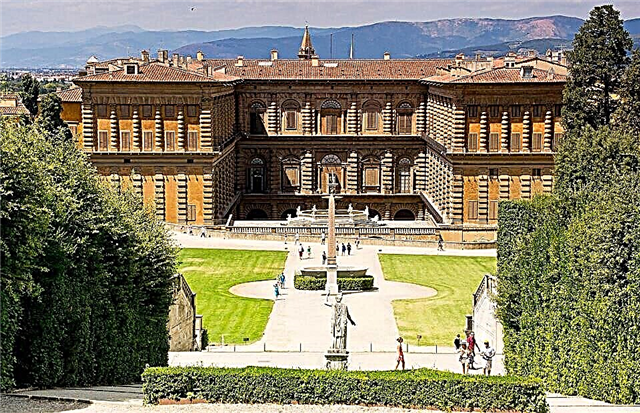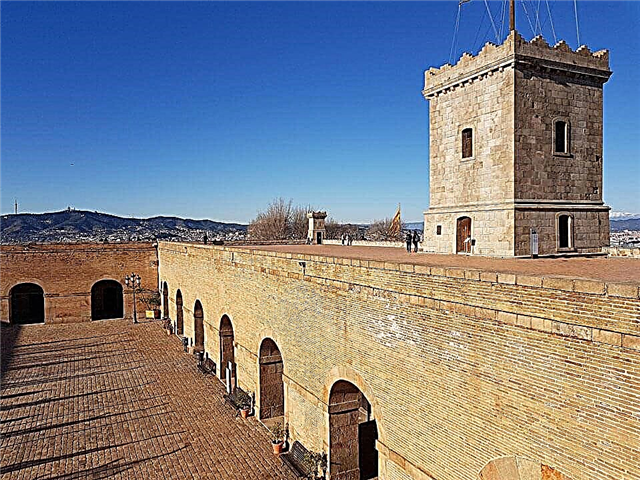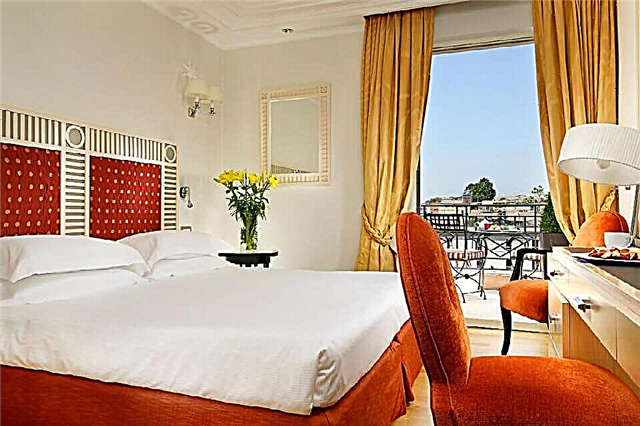A densely populated country located in a natural area rich in reservoirs, mountains and forests, the Czech Republic remains a popular tourist destination even after the collapse. Many beautiful resorts, nature reserves, unique sights, in addition to the brilliant Prague, attract travelers from all over the world. In the Czech Republic, there are authentic towns and villages full of their own charm that are definitely worth seeing.
Kutna Hora and Kostnitsa

Every Czech knows about a sacred object located in the outskirts of the city of Kutná Hora - Sedlec, visiting which, one is convinced how short a person's earthly life is. This is the famous, one-of-a-kind, Kostnitsa Church, where everything is made of human bones: crosses, chandeliers, ornaments of arches and vaults (according to rumors, 40 thousand bones were used). The history of the extraordinary church began in the 13th century, when the local monastery cemetery became a holy land, where representatives of all noble classes dreamed of being buried.
For 2 centuries, the cemetery had nowhere to grow, so they began to bury it again: they dug up bones and put them in the chapel. One of the monks made 6 high pyramids out of bleached bones - of which in 1870 the carver F. Rintu began to decorate the church with them. Now "Kostnitsa" is of great interest to tourists as an extraordinary shrine, where you can think about the eternal, reconsidering something in your life.
Pilsen Brewery

Not only beer lovers know that the best foamy drink is made in the Czech Republic, as evidenced by the Plze brewery. One of the oldest and most famous Czech breweries is located in Pilsen. Although now there is a modern plant with new production technologies, but the "heart" of the plant - the old workshops of the former brewery are still alive, they also brew beer. Tourists get acquainted with the stages of making beer, descend into the vast cellars, where the famous drink is kept in wooden tubs. A visit to the Museum of Brewing will be very interesting, where the history of the development of beer production and the life of those who stood at the origins is clearly illustrated. At the end of the excursion, everyone is allowed to taste "live", unfiltered beer. Visitors leave only positive feedback about their visit to the company.
Karlovy Vary

Everyone who comes to blessed Karlovy Vary fondly remembers Charles VI, who was once enchanted by lush greenery, thermal springs with steam clubs and the extraordinary beauty of these places (15th century). It was by his order that a village was founded here, which later became a famous spa resort with 12 types of mineral medicinal water. A majestic monument has been erected as a token of gratitude to the discoverer of the beautiful corner of the Czech Republic. Karlovy Vary (Karlsbad) was a favorite resort of many great personalities, not only as a resort where you can get medical treatment, but also as a city with a special pacifying atmosphere, contributing to the moral purification of the soul.
Streets immersed in luxurious greenery and amazingly beautiful flowers, enchanting surrounding landscapes, a forested area, magnificent hotels - everything here delights and sets you on the positive side. The following objects are interesting to visit: Hot Spring and Mill Colonnades, Church of St. Mary Magdalene, Peter and Paul Church, Goethe Tower, Jan Becher Museum, Museum of History and Local Lore, Dvořákovy Sady, etc. Having visited Karlovy Vary once, you can fall in love with them for life.
Moravia

The eastern region of the Czech Republic with a rich history was known as early as 4 centuries BC as an area inhabited by the ancient Celts. Many times Moravia passed from one state to another, and only since 1993 it became an administrative unit of the Czech Republic. Such a historical path could not but affect the appearance of the region, therefore in its cities there are so many ancient castles, cathedrals, churches, palaces. In Ostrava, the main attraction is the Silesian Ostrava Castle, surrounded by picturesque nature. Ostrava, admire the surrounding landscapes.
The Cathedral of the Divine Savior is an object of tourist pilgrimage. Spielberg Castle in Brno, the first building around which the city began to grow, captivates with its beauty. The mysterious castle of the White Lady - Pernstein will leave deep impressions. These are just a few examples of historical monuments in Moravia, they can be found in every town in the region.
Moravian Karst

The amazing natural karst reserve Moravian Karst is the largest among the karst massifs of CENTRAL Europe (more than 1100 karst grottoes). Tourists can have a very interesting time here, solving mysterious formations. There are 4 karst caves on the Punkva River available for visiting, amazing with their stalagmites, stalactites, huge underground corridors and abysses. Karst gorges Pustoe and Sukhoye trough capture the imagination, a walk along which is a journey into the unknown. The main mystery of the Moravian Karst - the Rudice sinkhole fascinates and surprises with the mysterious channel of the Edovnitskaya River, flowing underground and bursting out after 12 km. The reserve is valuable for its rich flora and fauna. The Moravian Karst is protected by the state.
Prague: hop-on hop-off bus, 24 or 48 hour ticket - 20 €
Prague: 45-minute sightseeing cruise to Čertovka Canal - 14 €
Tourist card in Prague for 2, 3 or 4 days - from 58 €
Prague: 50-minute river cruise - 13 €
Prague: New Years Eve Dinner Cruise with Fireworks - 160 €
Prague: folklore dinner with music and dancing - 57 €
Olomouc

Wonderful small town Olomouc (100 thousand sq. M.) On the banks of the river. The Moravians are a real "museum of antiquities". Its history began with a military camp, then with a powerful fortress, which became the center of the Olomouc appanage principality and the capital of the county of Moravia. Having experienced repeated devastation from wars, the city was reborn from ruins, and now it is one of the most beautiful cities in the Czech Republic, with a well-preserved historical center, a developed culture and educational system. 3 large squares and their surroundings make up the old town, the historical core from which Olomouc grew.
This district does not contain magnificent monuments of the past: the 25-meter Column of the Holy Trinity, the Town Hall with an astronomical clock and a Gothic chapel, a luxurious building of neoclassical architecture - the Moravian Theater, quite famous in the Czech Republic, St. Wenceslas Cathedral, etc. Trip to Olomouc - a journey into the medieval history of the Czech Republic.
Ardshpakh

A miracle of nature - the rocky town of Ardspach, located in the southeast of the Czech Republic, has become a place of pilgrimage for tourists who want to penetrate the secrets of bizarre rock formations. Hiking trails (3.5 km long) began to be built here in the 19th century, conventionally dividing the pile-up of rocks into the suburb and the city. Trails-routes are marked with green signs, equipped with directional signs so that no one gets lost. For 2 centuries, each expressive rock image has received its name by analogy with the object that it resembles.
In the suburb there are the Kuvshin rocks, the Sugarloaf (height 52 m) and other interesting objects. The Gothic Gate (1839) leads to the Rocky City, from which a gorge begins with a well-equipped path for tourists, leading to pl. Elephants (rock formations resemble the ears and trunks of elephants). Rocks Tooth, Devil's Bridge, Madonna, Silver Stream waterfall will amaze the imagination and will be remembered for a long time.
Brandis nad Labem

30 km from Prague there is an amazingly beautiful, picturesque settlement - Brandys nad Labem castle - the embodiment of several centuries of Czech history, starting from the 14th century.Representatives of many noble families in turn owned the architectural and park miracle, and from 1918 the castle began to belong to the state as a valuable historical and cultural monument. It is impossible to describe in words the beauty of all structures, murals, sculptural images, park landscape. This is a must-see in order to appreciate the cultural and material value of all the splendor. Today, this "Renaissance and Empire beauty" hosts various festivals, solemn meetings, chamber concerts, and wedding ceremonies. Nobody leaves here disappointed.
Terezin

The theme of the Jewish Holocaust will never disappear from the people's memory, and the small Czech town of Terezin is evidence of this, as is the recent poignant film by Pavel Chukhrai "Cold Tango" (we advise you to watch). Ancient fortress of the 17th century at first it served as a prison, and at the beginning of the war in 41-45 it became the first fascist concentration camp. Here, during ethnic cleansing, the Austro-Hungarian authorities killed tens of thousands of Russians who did not want to convert to Catholicism. Having taken possession of Terezin, the Nazis expelled the entire local population from it in order to turn the fortress into a Jewish ghetto, where they brought German and Austrian Jews under the pretext of deportation to the east.
In reality, they were sent to be exterminated at Auschwitz. 33 thousand people were burned in Terezín, out of 140 thousand who ended up in the ghetto, only 3 thousand survived. Now a memorial complex has been created here, passing through which you can clearly imagine in what inhuman conditions the unfortunate doomed were and what torments they experienced. At the huge cemetery there are memorial plaques - symbols of sorrow. There is a Columbarium, a ritual hall, a ghetto museum, a prayer house. Each of those present experiences a spiritual protest against the repetition of such atrocities.
Marianske Lazne

Better known as the city of Marienbad, Marianske Lazne is a wonderful spa resort that received this status back in the 19th century, turning from a small town into a fashionable European resort in 2 decades. There are many modern beautiful buildings here, but there are also interesting ancient architectural monuments inherited from past eras. One of them is the Tepla Monastery (late 12th century) with early Gothic buildings and later Baroque buildings. Within the walls of the monastery are kept valuable rarities - ancient books that you can see.
An excellently preserved architectural monument of the 17th century is the authentic castle-museum of Kunžvart, where the exhibits are original furniture and things of the previous owners. There are many churches in the city, among them the church of St. Vladimir and the Catholic Church of the Virgin Mary. The resort is associated with the names of Chopin and Goethe - there are their museums, which have become popular tourist attractions. Visitors love to walk under the Colonnade in the city center, where the enchanting Singing Fountain is installed. The beautiful parks of Marianske Lazne (Geological, Boheminium) are very interesting to visit.
Benatki nad Jizerou

The main attraction of this Czech city, for the sake of which tourists come here, is the palace castle of the 16th century, in which Emperor Rudolf II and the court alchemist and astronomer in one person Brahe lived for some time. It is no coincidence that there is a laboratory in which an anti-plague medicine was allegedly invented, and an observatory. One of the expositions of the castle tells about the life of a scientist, the second is devoted to the stay in the castle of the great composer Smetana. Many are interested in the Toy Museum in the castle, where unique old dolls, various cars, scooters are presented. Local churches attract the attention of tourists: the church of St. Mary Magdalene, Sagrada Familia chapel, Church of the Assumption of the Virgin Mary.
Czech krumlov

A captivating fairy tale of the Middle Ages opens to visitors to Cesky Krumlov, enchanting sight from the first steps with its medieval appearance. Its location is also surprising: the blue "ribbon" of the Vltava zigzags along the streets and squares of the city, dividing it into islands. The view of Krumlov from above is uniquely picturesque: it really resembles a fairytale city where the distant past comes to life. The Gluboka castle complex (13th century) near the Vltava is irresistibly beautiful and unique - an undoubted masterpiece of architecture and an important historical monument.
In the very heart of the city there is one more castle - Krumlov (early 13th century), in which everything has been preserved in its original form, for which it received the status of a state reserve (1989).
The raincoat 3-level bridge is a unique multifunctional building - a popular place in the city. It is worth visiting the Church of St. Vita is a symbol of splendor and power (14th century), still active. Noteworthy is the ancient Cistercian monastery of Vyshy Brod (13th century) - a monument of national culture, which is still in operation.
Hluboka nad Vltavou castle

In Cesky Krumlov, on the rocky bank of the Vltava, there is a truly architectural "pearl" of the Czech Republic, erected here around the middle of the 13th century. The external appearance of the castle mixed Gothic, Renaissance and Baroque styles. The last reconstruction of the 17th century, carried out by the aristocrats Schwarzenberger, gave the castle a neo-Gothic appearance, irresistibly beautiful. The castle can be admired as a real work of art. Inside, everything is also worthy of admiration: a rich collection of Flemish tapestries, paintings by the famous painter Hamilton, a unique fireplace decorated with granite, golden sleighs, luxurious furniture, cutlery, crockery - amaze with grace and beauty.
Karlštejn Castle

Not far from Prague (28 km) on a high, inaccessible rock rises a truly fabulous Gothic castle Karlštejn (Karl's stone). The picturesque mountain river Berounki flows next to it. Charles VI did not accidentally choose this place for his residence - none of the numerous enemies was able to lay siege to the fortress. After the death of Charles VI, the castle suffered a sad fate: the owners changed, but no one cared about its preservation until it was handed over to the state. After a grandiose reconstruction, the castle with the Imperial Palace, the Mariana and the Great Tower, the Chapel of the Holy Cross became a place of pilgrimage for tourists. You can come here by train, regular or tourist bus. A signposted road leads from the railway station to the castle.











